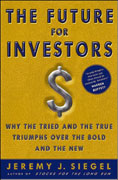In his 1994 best seller, Stocks for the Long Run, Wharton finance professor Jeremy Siegel showed investors that stocks, rather than bonds or cash, are the most profitable long-term investments, and he endorsed index-style investing. But investors wanted to know more. “I gave scores of talks across the country on Stocks for the Long Run,” Siegel recalled recently. “The two questions I received most were: ‘Which stocks for the long run?’ and, ‘What about the age wave and the baby boom?'”
Siegel’s response was voluminous research for his new book, The Future for Investors: Why the Tried and True Triumph Over the Bold and the New. The unexpected conclusion: It’s not the hot, new-industry stocks that serve investors best. More often it’s the humdrum, traditional firms that sell cigarettes, pump oil or peddle soft drinks and chewing gum. Siegel concluded that investors can improve on index-style investing by also holding stocks with low price-to-earnings ratios and high dividend yields, and by putting as much as 40% of their stock portfolios into foreign issues. “Indexing is great,” he said in an interview. “But now, after doing all my research, I think we can do a little better.” A proper mix could boost annual returns to one or two percentage points above those provided by indexing, he noted.
For his new work, Siegel searched through the Standard & Poor’s 500 Index to find patterns among the winners and losers. “I was frankly shocked that Philip Morris would be the number-one stock,” Siegel said. “I would just never have guessed that. I would have said, ‘Maybe IBM.'” From 1925 through the end of 2003, tobacco company Philip Morris, now called Altria Group, delivered a 17% average annual return, assuming all dividends were reinvested in the company’s shares. That beat the average stock by 7.3 percentage points a year. A $1,000 investment in Philip Morris in 1925 would now be worth more than a quarter of a billion dollars.
Similarly, consider a choice available to an investor in 1950 who could have put money into the most cutting-edge company of the day, computer maker IBM, or the numbingly ordinary Standard Oil of New Jersey. Even today, most investors would assume IBM was the best bet. Indeed, according to the most widely watched measures of growth, IBM was the winner over the next 53 years, dramatically outstripping Standard Oil in per-share growth of revenue, dividends and earnings.
But Standard Oil shareholders did better, with average annual returns of 14.42% versus 13.83% for IBM. That half-point difference, compounded over 53 years, put the oil-company shareholders ahead by more than 25%. A $1,000 investment in Standard Oil would have grown to $1.26 million, compared to less than $1 million for an equal investment in IBM.
Siegel found similar results again and again. Since 1950, the top-performing companies were National Dairy Products (now Kraft Foods), returning 15.47% a year; R.J. Reynolds Tobacco, 15.16%; Standard Oil of New Jersey (now ExxonMobil), 14.42%; and Coca-Cola, 14.33%. A $4,000 investment in the top four would have grown to $6.29 million, versus $1.11 million for a similar investment in the stock market as a whole.
The “Growth Trap”
What causes the out-performance of the prosaic old-style stocks over the more exciting trailblazers? “The answer is simple,” Siegel writes. “Although the earnings, sales and even market values of the new firms grew faster than those of the older firms, the price investors paid for these stocks was simply too high to generate good returns. These higher prices meant lower dividend yields and therefore fewer shares accumulated through reinvesting dividends.”
Siegel calls it the “growth trap” – investors’ tendency to pay too much for shares in fast-growing companies, largely because they expect too much growth in the future. From 1950 through 2003, IBM shares sold at an average price 26.76 times annual earnings, while Standard Oil traded at 12.97 times earnings. IBM’s dividend yield (annual dividends divided by share price) was 2.18%, while Standard Oil’s was 5.19%.
The higher dividend yield allowed Standard Oil shareholders to accumulate many more shares, causing returns to snowball. “Dividends matter a lot,” Siegel writes. “Reinvesting dividends is the critical factor giving the edge to most winning stocks in the long run … The return on stocks depends not on earnings growth but solely on whether this earnings growth exceeds what investors expected, and those growth expectations are embodied in the price-to-earnings, or P/E ratio. Portfolios invested in the lowest P/E stocks in the S&P 500 Index returned almost 3% per year more than the S&P 500 index, while those invested in high-P/E stocks fell 2% per year behind the index.”
Will the patterns Siegel found over the past half century hold in the future? Siegel thinks they will, although stock-market investors face serious challenges examined in the second half of his book.
Many experts worry, for example, that there will not be enough younger Americans to soak up all the securities that baby boomers will want to sell to fund their retirements, with the excess supply driving down share prices and returns. Indeed, most of the industrialized nations will have aging populations, largely because of low fertility rates and longer life expectancies. In 1950, there were seven American workers for every retiree 65 or older. Today there are 4.9, and in 2050 there will be just 2.6. In Japan, there were 10 workers per retiree in 1950; there are 3.1 today and will be 1.3 in 2050.
One way to address the problem: Gradually increase the retirement age in the U.S. to 73 by 2050. That would cut the number of years the average American has in retirement by a third, from about 14.4 years today to 9.2 years. Another possible solution: Hope that rising productivity will allow fewer workers to support more retirees. But Siegel finds this unrealistic, as it would require U.S. productivity to grow 7% a year, more than triple the historical rate. That’s nearly impossible for an economy that is already well developed.
But Siegel believes the developing world will come to the rescue: There will be plenty of affluent, young people in China, India and other countries to buy the stocks Americans will want to sell. “If the developing world can increase productivity at a 6% rate per year over the next several decades — and these rates have now been surpassed in China and India — then the retirement age of the boomer population need only rise modestly and still enable a comfortable retirement,” he writes.
Economic advances in countries like China and India will give enormous buying power to their people, whose average age will be lower than in the developed nations. The developing nations will supply the goods that retired Americans will need, and they will buy the securities baby boomers will want to sell, creating enough demand to shore up equity prices, Siegel said, adding that the Chinese economy will be twice the size of America’s by mid-century if China’s per-capita income rises to half of America’s. That’s not an unlikely feat: In the past half-century, Japan, Hong Kong, Singapore and a number of other countries have achieved growth rates higher than that. “The future of the world economy is bright,” Siegel writes.
Siegel found that historically the biggest factor in productivity growth has been advances in communication — writing, the printing press, telegraph and telephone, and the Internet. Communication improvements should spur high productivity growth in the developing world, he said. “The Internet can play a role today akin to Ts’ai Lun’s development of paper in the first century and Johannes Guttenberg’s invention of the printing press in the fifteenth,” Siegel writes. “The communications revolution has set the stage for the entire world to experience robust economic growth.”
High growth in developing countries will spur high stock returns in many of those countries, making foreign stocks attractive to Americans, Siegel said. But he cautions against falling into the growth trap. Since many investors already expect good stock returns in China and India, stocks in those countries may already be priced too high to provide top-level returns in coming decades — just as IBM shares were priced too high over the past 50 years.
China grew dramatically in the 1990s, but over-enthusiasm among investors made Chinese stocks overpriced. A $1,000 investment in an index of Chinese stocks in 1992 would have fallen to $320 by the end of 2003. Meanwhile, an identical investment in Brazil, which began the 1990s in political and economic turmoil and was spurned by most investors, would have grown to $4,781. “The conventional wisdom that investors should buy stocks in the fastest-growing countries is wrong for the same reason that buying the fastest-growing firms is wrong,” Siegel writes.
Investing in developing nations is risky. Investors cannot be certain that other troubled countries will recover as Brazil did, or that currency fluctuations will not wipe out Americans’ gains in foreign stocks. To avoid putting too much money into any one region or country, Siegel recommends allocating a stock portfolio with an eye to each country’s share of world equity values — U.S. and Canada, 54.9%; Europe, 27.8%; Japan, 9.1%; other developed Asian countries (Australia, Hong Kong, Singapore and New Zealand), 3.2%.
As a group, emerging markets should get 4.9% — Korea, 0.9%; Taiwan, 0.5%; China, 0.4%; Brazil, 0.4%; Mexico, 0.3%; India, 0.3%; Russia, 0.2%; and other emerging countries, 1.9%.
A number of mutual fund companies offer indexed funds and exchange-traded funds for U.S. and foreign stocks, allowing investors to own a wide assortment of stocks in a variety of countries at very low cost, Siegel said.
Investors should continue to rely on indexing as the core of their portfolios, he added, but they should devote about half of their portfolios to “return-enhancing strategies” based on his findings about the benefits of high dividend yields and low price-to-earnings ratios. High dividend strategies, for example, include investment in groups of stocks such as the Dow 10 and S&P 10, which focus on issues in those indexes with the highest dividend yields. Real estate investment trusts are also attractive because of their high dividends.
Investors also should consider stocks in firms that operate globally, such as those in the S&P Global 100 Index and the Dow Jones Global Titans Index. And they should look at the sectors that have produced good long-term results that many investors did not expect — oil and natural resources firms, global pharmaceutical companies and those that produce well-known consumer staples. “Avoiding the growth trap and sticking with the tried and true has served investors very well in the past,” Siegel concludes. “There is no reason why those strategies will not continue to serve investors well in the future.”



